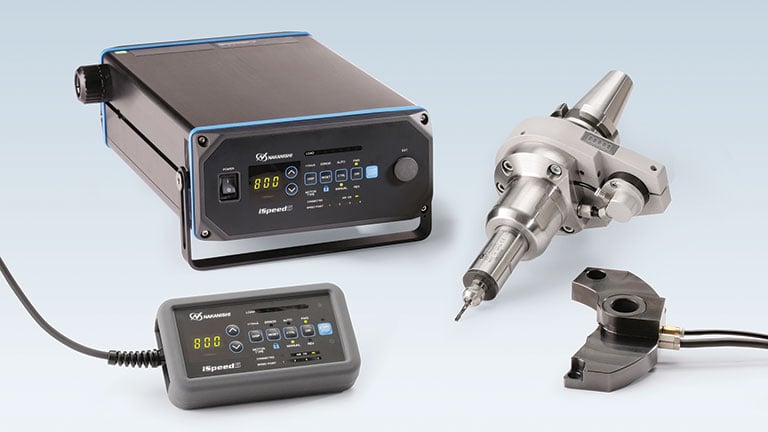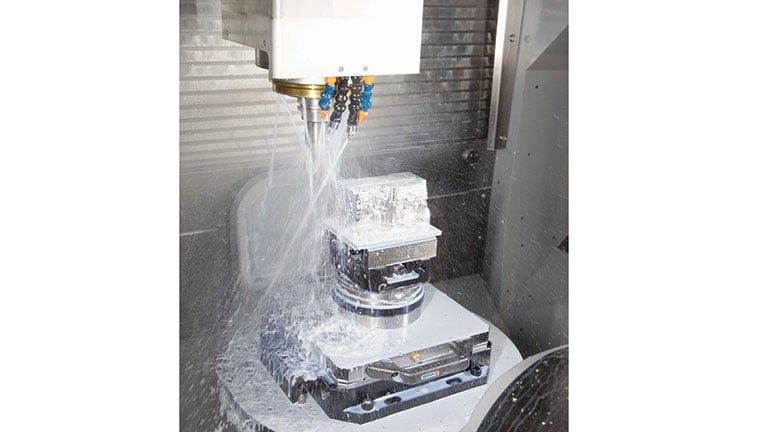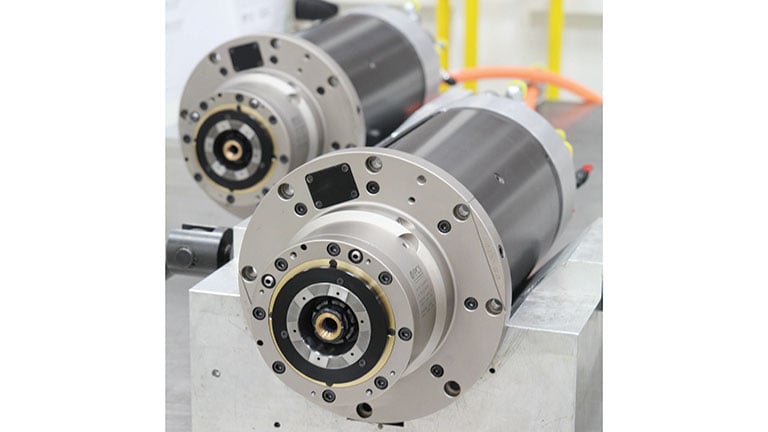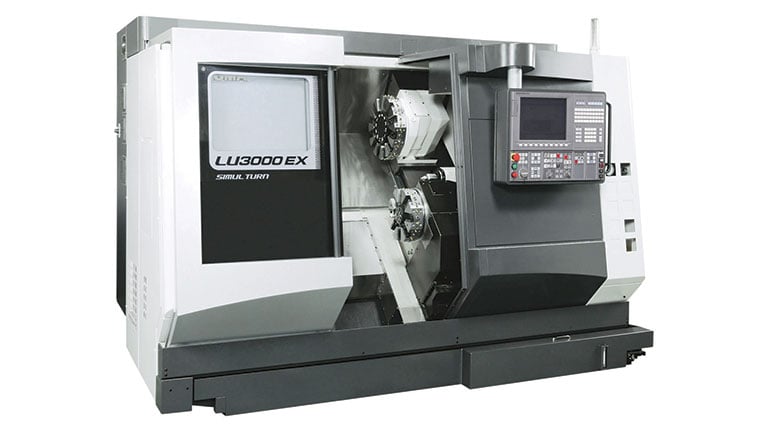New spindle technology turns faster, lasts longer and is getting smarter.

Driven spindles are the technical core of a machine tool, supplying the power to turn the cutting tools that shape our products and our world. Attaching one to a five-axis movement creates an advanced CNC machine. Attaching a spindle to an articulated arm robot creates a precision drilling machine. Attach an improved one to an existing machine and new applications come to life. Across the spectrum of uses, customers want spindles with more durability, speed, and the smarts to run lights-out operations.
The possibilities for creative use of spindles is limited only by how much faster, durable and smarter today’s spindles are getting.
Small Tools Demand Speed, Accuracy
Customer requirements start with improved speed and accuracy, according to Greg Nottoli, senior product manager at NSK America Corp., Hoffman Estates, Illinois. One of the specialties of NSK is providing electric- and air-driven spindles for microtools. Microtools are any mill or drill round tool that is 1/8" (3.18 mm) or less to as small as 0.001" (0.025 mm) in diameter. “A small-diameter tool is basically a wet noodle, very easy to break. When turning a drill or a mill, the smaller the diameter of the tool, the faster it needs to spin to be effective,” said Nottoli, while maintaining rigidity for accuracy. Many CNC machines do just fine turning standard tools at 8,000 to 15,000 rpm. Microtools often need to go up to 42,000 rpm, according to Nottoli. “Using a microtool with an 8,000-rpm spindle is not optimal, because you’re not evacuating the chip right, not getting the right surface footage, and just breaking the tools. That’s where we fill the gap in this specialized market,” he said.
According to Nottoli, spindles available from NSK can post-fit any machine with an existing toolholder, such as CAT 40, 50, or BT. “It allows the end user to get those higher speeds,” he said, adding that these are true spindles, not speed multiplier devices that convert the speed of an existing spindle into a higher rpm. A speed multiplier is “a box with gears,” he said. While it can provide the needed speed and accuracy with minimal loss of power for standard tools, it also introduces vibration and heat. Those are problems for micro-machining where accuracy is specified in sub-microns.
“We have spindles for turning centers and grinding machines or specially built robotic machines,” said Nottoli. “If it is a machining center, our spindle goes up into the machine spindle [space] and provides its own rotation.” The machining center provides the axis positioning, the NSK spindle the power.
While pneumatic and electric each have their applications, Nottoli also noted the advantages of electric. “The best bang for your buck is going to be with electric. Our electric motors are brushless DC in a closed-loop controller. With our controller, once the speed is dialed to the thousand rpm, it keeps the spindle at that speed once the cutting tool engages. Not so with a pneumatic attachment spindle, since once it engages a part, the rpms typically drop,” he explained. “We can try to control it with a regulator. But there’s really no active feedback to control it.”
The newest electric spindle from NSK, the iSpeed5, boasts speeds up to 80,000 rpm with a maximum output power of 350 W. It is a fully tool changeable system consisting of a motor spindle, stop block, air pressure switch and control unit. Power, cooling air, and control signals are provided to the spindle when engaged to the electromechanical stop block that attaches to a machine tool spindle. Ceramic bearings enable these high rpms.
Accuracy, Versatility, and Control
William Gillcrist, national product manager and applications manager for MC Machinery Systems, Inc., Elk Grove Illinois, agreed that more speed and power are important in new spindles and emphasized accuracy as well. “In high accuracy applications you have to make sure that tool is spinning perfectly true, so bearing technologies are important,” he said. “Runout and minimizing the growth of the spindle using high tech bearings is critical,” he said. That means ceramic or air bearings when rpms reach above 20,000. Just as important is longer spindle life. A spindle may be the most expensive component of a machine tool and treating it like a consumable impacts the bottom line.

But not all new spindle technology delivers high speeds, low runout, and low vibration with smaller bearings and long life. Spindles are still needed that deliver high torque and high metal removal rates, at lower rpms. This puts significant stress on bearings and components. Ideally, a single spindle would deliver both high torque/low rpm and low torque/high rpm. “What we’ve been seeing are better spindles that have more torque and speed, providing torque at lower speeds yet still able to reach higher rpms well above 30,000. High torque married to the highest speed in a long-living spindle is what most people want,” said Gillcrist. He also offers a practical tip—it is high torque that limits spindle life.
Another important factor to compensate for is heat-induced expansion. Controlling radial runout is important, but so is spindle growth in the axial direction. “One of the main things that we see in the machines we’re selling is the ability to control or adapt to any spindle growth,” explained Gillcrist. “If I’m trying to hold a real tight Z depth on a mold, I can’t have my spindle fluctuating.” His answer is collecting data and making compensations through the machine controls.
The two most common methods to adjust for spindle growth are the algorithmic method, inferring spindle growth mathematically from temperature and time against laboratory collected curves, and the direct gap sensing method, according to Gillcrist.
The direct method is becoming more practical because of improvements in sensors. “We have real-time gap sensing on some of the machines that can adjust [position] in real time if there is any growth or change, if the tool is wearing or when the tool is not engaged at all. The algorithm style seems to not be as favorable [today]. But we also have a manufacturer that uses both, in a five-axis environment, so that they can capture everything as far as thermal/time predictions and actual gap” are concerned, said Gillcrist.
Smart Spindles, Smart Drilling
There are several reasons why data is becoming so important, from closed-loop machining processes to feeding data into a smart factory data pool. But, for it to be useful, data must be transferred. “Connectivity is important in the advancement of spindle technology,” said Max Paulet, business development manager, North America for PCI-SCEMM, which is based in Saint-Etienne, France and Mason, Ohio and partners with Absolute Machine Tools, Lorain, Ohio. “I think everybody is trying to make the machine more intelligent, more autonomous by gathering data very close to the cutting tool and the part it is cutting.”

PCI-SCEMM now offers its electro-spindle, or e-SPINDLE, to give these options to machine builders. It is available in North America from Absolute Machine Tools. According to Paulet, the e-SPINDLE system integrates sensors on the cutting tools or toolholders—not further up on the spindle. “The sensors are thus close to the cutting area or designated measurement area, ensuring high-quality data collection and processing,” he said. There is flexibility, if standard tools are used, the spindle will act as a standard, non-connected spindle. Almost any kind of sensor, such as accelerometer, effort gauge, thermocouple, or motion generation devices, such as piezoelectric actuator, electrical drive, or thermal drive can be used.
What kind of sensors are most useful to end-users? According to Paulet, vibration, torque, and—when drilling or milling holes—sensors that measure the diameter of the hole. “Vibration measurement is what we started with, and it is very powerful; there are many effects you can measure and control with vibration,” he said. By measuring the baseline vibration pattern with a process under control, any variation from that vibration target means problems. If contact between the part and the tool is wrong, if the tool is broken, unbalanced, or chattering, the vibration pattern will alert the controller to adjust, or in the worst case, shut the process down and alert an operator.
“The second most common sensor is torque,” said Paulet. Torque variations again provide useful information about processes going wrong. Abrupt changes in its pattern can detect chatter or a broken tool, as well as expected changes in material. “By also combining torque with vibration gives a richer real-time understanding of the process,” he said. He noted that this is useful in drilling holes for joining dissimilar materials, like aluminum and carbon-fiber reinforced plastics (CFRP) common in aerospace. The control is smart enough to adjust the drill as it cuts from aluminum to CFRP to aluminum in a stacked material.
The third most common sensor, Paulet noted, is measuring diameters in-process. The company uses a laser gage, measuring continuously when cutting tools are inside a cylinder bore, sending data to the controller what the actual diameter is at that instant. “By measuring a diameter in-process, you can adjust that process and know either how much material to remove or to compensate the spindle,” explained Paulet. “This makes for accurate drilling and milling within microns.”

Better Machines, Better Spindles
Wade Anderson, product specialist sales manager for Okuma Americas Corp., Charlotte, N.C., also noted demand for even better machine performance, reliability and machine up-time. Okuma not only builds machine tools, it also makes the spindles that go into them. “With the trend in [improved] performance, I see rpms and horsepower increasing, which means higher torque as well,” said Anderson. “It wasn’t all that long ago when I was using machines with 10-hp (7.46-kW) spindle motors on them. Now we’ve got machines running 30, 40, 60, even 75-hp spindle motors.” That translates to a range of 22 to 56 kW. This isn’t just the case of spindles getting better. Those improvements are being matched by improvements in machines and tooling technology. Together, this allows manufacturers to accurately cut ever more difficult materials.
More power from the spindle is good. The heat it generates is bad. “One of the biggest heat generators of any machine is the spindle motor. That’s usually one of the biggest motors on the machine tool,” explained Anderson.
How does Okuma control that heat? “We focus a lot of time and attention on the thermal dynamics of the machine and live, real-time measurements,” he said. “We measure the spindle temperatures and through thermal mapping we can offset the machine kinematics as needed. We call this system TAS (thermo active stabilizer), and coupled with our proprietary spindle cooling technologies, it gives us the tools needed to [create] one of the most thermally stable machine platforms available.”
How about reliability and machine uptime? Anderson cautioned that while it is good to calculate cycle time for a nominal operation, one should focus on the efficiency of the entire process, especially in identifying and eliminating unexpected downtime. “If I can make a part extremely fast, I may be beating up the machine and tearing the spindle apart prematurely,” he said. Remember, high-torque applications can create situations that can affect spindle life. “If all of a sudden the machine is down because it or the spindle is damaged, that costs me a whole lot more than a slower cycle time.”
However, a too-slow cycle will also cost money. How best to optimize the cycle time? It requires data, knowledge and judgment. Okuma offers the ability to optimize a metal-cutting process with data derived from sensors combined with knowledge and judgment from artificial intelligence (AI). Baselining a process for a new machine in terms of fundamental measurements such as vibration, horsepower, and torque (creating a fingerprint) is a good idea, according to Anderson. Based on the fingerprint, the controller can detect when the process is deviating from the baseline.
As a result, machinists can run a fast cycle with more assurance that the machine will send an alarm when it is hitting a redline and automatically intervene to prevent catastrophic downtime. Processes are optimized and costs are contained. “Predicting failure before it happens raises the bar on your manufacturing process,” he said.
Lathes and Live Tooling in the Modern World

It may seem counterintuitive, but the ability to turn a tool can be important in lathe operations. Lathes, by definition, turn the workpiece and use a static tool to cut cylindrical features in the workpiece. However, to drill holes or cut flats in a simple lathe, a machinist has to move the piece off the lathe and reset it on a CNC mill.
“Live tooling uses the turret drive of the machine,” said Preben Hansen, president of Platinum Tooling, Prospect Heights, Illinois. In machines equipped with live tools, the workpiece is stopped, a cutting tool that turns is engaged and holes are drilled or flats milled. “They are driven by the turret of the machine, which you can call a spindle. Think of what we provide as a transmission, a set of gears that uses the motor in the turret of the lathe to turn the live tool.” These live tools can tune the gear ratio, up or down, depending on whether the application needs speed versus torque. Platinum Tooling offers live tools from Heimatec.
What are customers asking for? “Speed is the most critical feature. They want to turn their tools faster,” said Hansen. Speed means money, so that makes sense, but it’s not all they want. “What is becoming just as important is live tooling with sensors so that they can use data for monitoring. It is a huge issue to address right now.” There is a need for spindles for live tooling that monitor operating time, speeds, humidity, and temperatures. “Heat is bad for bearings, so monitoring and controlling temperatures means the bearings and spindles will last longer,” said Hansen. “Humidity is also bad for the device. A moisture sensor can give an alarm to immediately shut it down and not have any catastrophic failures.”
What is the ultimate goal of these sensor-based systems? “Faster operation, real-time monitoring of cutting operations, and ultimately lights-out operations,” he said.
"machine" - Google News
January 20, 2021 at 08:02PM
https://ift.tt/3sF2Ahr
Fast Times for Machine Spindles - Advanced Manufacturing
"machine" - Google News
https://ift.tt/2VUJ7uS
https://ift.tt/2SvsFPt
Bagikan Berita Ini















0 Response to "Fast Times for Machine Spindles - Advanced Manufacturing"
Post a Comment